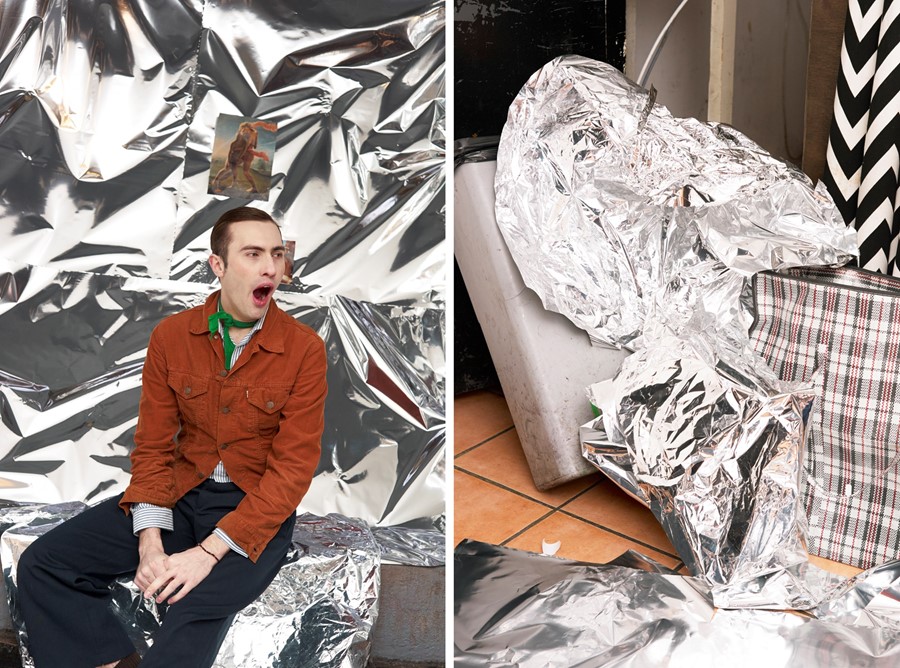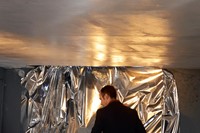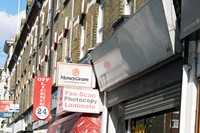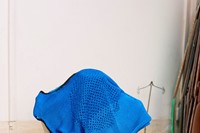We visit the studio of the Loverboy whose ‘drunk tailoring’, outré accessories and queer-tastic club nights are electrifying the capital
Charles Jeffrey is not a fashion designer; Charles Jeffrey is a self-appointed “creative director, darling”. As a member of Fashion East’s MAN line-up and a recent graduate from Central Saint Martins’ prestigious MA Fashion course, it takes guts and a heavy dose of self-awareness to wear that title with the confidence and ease that Jeffrey does. Most designers of his age are keen to express an image of humble, monastic servitude to their craft. Jeffrey, however, is far too fabulous for that.
It’s a Thursday afternoon at his studio at Dalston’s Vogue Fabrics (or VFD, as it’s called now), where his space is akin to a showgirl’s dressing room with plumes of ostrich feathers, sequined sculptures and platform heels scattered across the cabinets and shelves. Jeffrey is having his make-up done (“heavy blush, please – like Filip and Kito!”), as well as art directing a photo shoot and overseeing a flock of helpers covering every visible surface of the nightclub’s basement in reflective silver cellophane that he found discarded on the street. The result is a cross between an interstellar spaceship and a temple of Bernini-esque Baroque. It’s by far the most bizarre setting for an interview I’ve ever encountered.
The hands on deck downstairs are getting the venue ready for Loverboy, the club night that started as one of Jeffrey’s birthday parties as a student and has now escalated into one of the most vibrant, queer-tastic nights on the scene, as well a vital melting pot of inspiration for Jeffrey’s designs. “At the very beginning, everyone on the MA rolled their eyes at it as though I should be focusing on my work,” he says, adding that [the course’s late professor] Louise Wilson didn’t particularly approve of it. “It developed and we started to photograph it a lot more seriously and put more consideration into it. I remember discussing with Princess Julia that, in this environment people are so much more likely to collaborate – plus, it’s so much more joyous. It’s a form of expression that people are looking at and everything about it informs the process.”
Jeffrey’s process is interesting in its utter lack of tradition and structure. Early on in his MA, the feedback he received from Fabio Piras was to avoid sketches and toiles (“too pretentious”, he said) and instead concentrate on bringing his own flair for styling and sartorial quirks into his final collection. “I’ve never been talented with pattern cutting or working in a way that I saw my fellow students work,” he recalls. “Whereas they take an aspect and apply it to trousers or a dress or a top – the Louise way – I’ve always been anxious that I’ve never been able to be like that because I don’t have the capacity to sit and think. Even when I draw, it’s very quickly.” Nonetheless, during his placement year in 2012, Jeffrey worked as a retail assistant and subsequently design assistant at Jack Wills, in order to save enough money to do an internship in the haute couture ateliers at Christian Dior: training of the highest calibre.
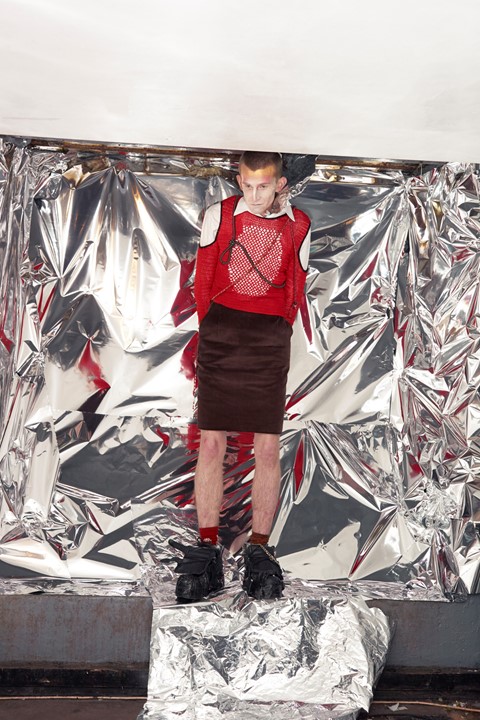
Jeffrey currently works with his long-time collaborator Jack Appleyard, whom he stopped in the street because he looked exactly like his illustrations. Together, they begin by compiling a stack of research laden with countless images of his glittering gang of Loverboy-goers. “Jack and I lock ourselves in my room, get rid of the bed, put all of our clothes on a rail and spend four days photographing ourselves in different looks – it’s that kind of idea,” he explains. He then briefs his pattern cutter and seamstress and continues to add to each look (note: not garment). How does Charles feel about using other creatives’ outfits for his own label? “We’re honest about where it comes from,” he answers. “I like looking at what people are wearing because it’s a lot more truthful, but I’m fully aware that people put a lot of effort into what they wear and then it’s got my name on.”
The 25-year-old designer’s interests in nightlife and its aesthetic aren’t surprising considering he experienced the “last cough” of Boombox and Ponystep-era London, where the idea of dressing up outrageously was still very much in vogue. “In halls, me and my friend Rachel made these outfits for Ponystep,” he remembers. “I had a roll of parcel tape and cut in little holes and we wrapped that around with tulle, and looking back that was so important.” Jeffrey, like so many of London’s dedicated dressers, relishes that period and is disappointed by the rise of streetwear-dominated nightlife (think normcore sweatshirts and Supreme T-shirts). “It’s very masc,” he smiles, knowingly referring to the label that some gay men adopt to convey heteronormative masculinity.
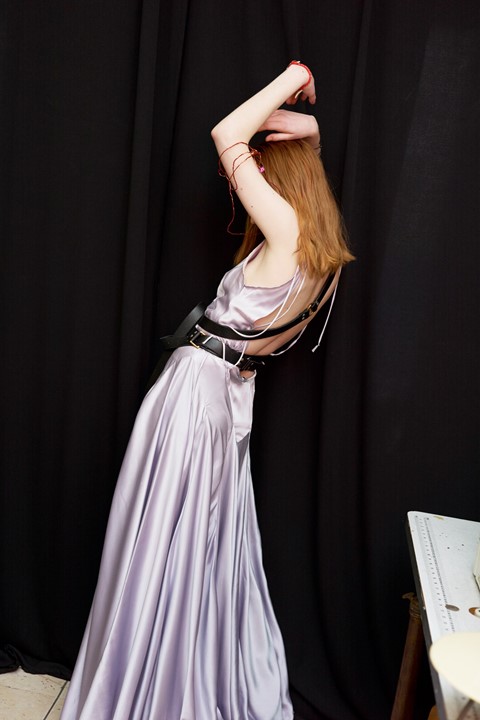
The interview gathers speed as we zoom to west London’s Selfridges in an Uber, where Jeffrey is set to DJ at the launch of Beth Ditto’s new fashion line. As we’re driving through Dalston, with model-slash-assistant Georgie in the front seat, Jeffrey begins recalling his upbringing in Cumbernauld, a small man-made town near Glasgow, with he settled with his mother at the age of ten. He describes his adolescent interests as MySpace-induced ‘emo’. “As soon as I saw The Horrors on the cover of NME, I became obsessed,” he enthuses. “That literally changed my life. I had never even heard of A Flock of Seagulls. I saw the video for Sheena Is A Parasite with Samantha Morton convulsing and I was like, who are these people? Why are they so cool? How can I look like them? I got so obsessed I grew my hair out and backcombed it and wore loads of eyeliner and the skinniest of jeans.”
Other influences included Patrick Wolf (“so poetic,” he sighs) and Vivienne Westwood, his mother’s favourite designer. Was it difficult being so colourful in such a small Scottish town? “I was always getting chased by Neds, so there was that side of it,” he offers, “but it just made me want to dress up more.” Today, Loverboy has become a safe haven for outré characters, creating a community of likeminded creatives that are able to express themselves without persecution. “There was a nasty guy preying on one boy, Aidan, who’s fairly small,” he begins recounting of an incident at the last Loverboy in August, a night so packed that not even FKA twigs and Gareth Pugh could get in. “All of a sudden a swarm of queers crowded around this angry man and I got really uppity and started screaming, with my face painted blue and a huge red circle on my forehead, ‘You’re in the minority now!’”

As part of the designer’s A/W16 collection, which he recently took to Paris for sales showrooms, he collaborated with Chittleborough & Morgan, the Savile Row firm founded by former Tommy Nutter tailors, Roy Chittleborough and Joe Morgan. The result was Jeffrey’s ‘drunk tailoring’, a jaunty style of slightly jaunty two-piece suits (Jeffrey is always sporting a bit of tailoring), complete with oversized shoulders, slouchy fit and secret gin pockets. “I had this idea of making it oversized and changing the shape of the body, the same way that most Savile Row suits do,” he says, “but making it look like something you’ve found in a charity shop and can easily slip on and off.” As well as the tailoring, all of the club kid knits were crafted from Scottish cashmere and the denim was hand-painted by Jeffrey.
“I was watching Vivienne Westwood in conversation with Jeremy Paxman the other day and she was talking about how haute couture techniques inform so much other work and losing that in favour of something that just makes money is completely losing the soul of something.” For Jeffrey, the opportunity to work with esteemed mills and tailoring firms allowed him to bring a vital element of technique to his predominantly image-led approach to design. When asked about how Savile Row felt about Loverboy, he proffers a witty story about a time that he turned up to the firm wearing PVC trousers and a vest top. “One of the customers looked at me and made this disapproving sound,” he smiles, as though he’s excited by what came next. “The head tailor, who is in his 70s, turned around and said, ‘To huff at the younger generation is to huff at culture in general.’ This is a man whose shirt is suffocating him and yet he’s so much more open minded!”
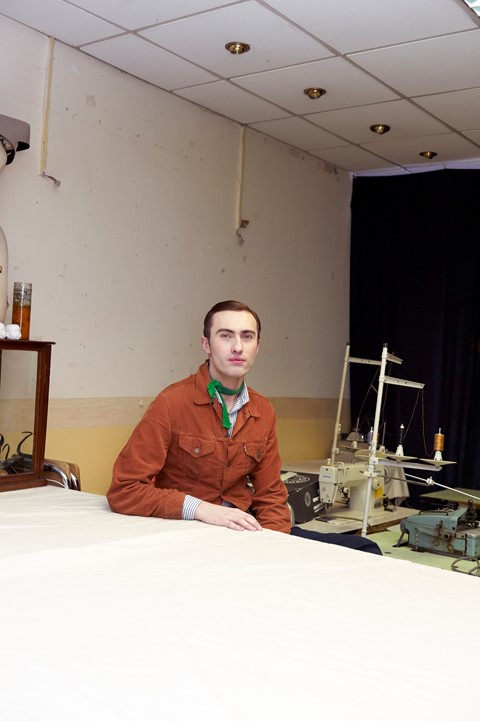
For Lulu Kennedy, founder of Fashion East, it was Jeffrey’s MA collection that secured his place on the sponsorship scheme that has fostered the success of countless London-based designers. “I was blown away by his restless energy,” says Kennedy, who says that she recognised something similar in Jonathan Anderson. “What I loved about his collection was that it felt believable. There were trousers, jackets, and jumpers, but he had pushed them in a way that they felt really new and authentic. It wasn’t just arty and paint-splattered – there’s great product and he has a real knack for clothes and making people look good. Talent like that doesn’t come around often.”
She points out that one his best qualities is that he’s good at delegating what he’s not very good at, which includes the business side of starting a label. “I do put my head in the sand when I have any issues so there are a lot of issues that I don’t even want to say out loud,” confesses Jeffrey. He says that Fashion East has been pivotal in helping with that rather murkier side of things and that there’s never been a phone call with them that hasn’t resulted in his questions answered and him feeling relieved and altogether less anxious. There’s also Glasgow-based Tessa Hartmann, the Scottish PR guru who runs the Scottish Fashion Awards and has been a patroness to Jeffrey since crowning him Graduate of the Year last August. One of the biggest challenges, he says, is putting the bespoke, hand-made elements into wider production. “That’s why you see a lot of designers ending up making T-shirts and sweatshirts with a weird print on it,” he says. “It becomes about how much margin you can make to pay your rent. You see people and you’re like, how are you getting so shit now? Then you realise that’s it’s not that they’re lazy – it’s that they’re freaking out about money.”
With that, the cab arrives at Selfridges and Jeffrey is off to fulfil another one of his several creative endeavours – all in the name of keeping his label alight. What’s next for the designer, I mean, creative director? Well, Loverboy, of course – and from there, the world.
Make-up Mini Honour Blackman
